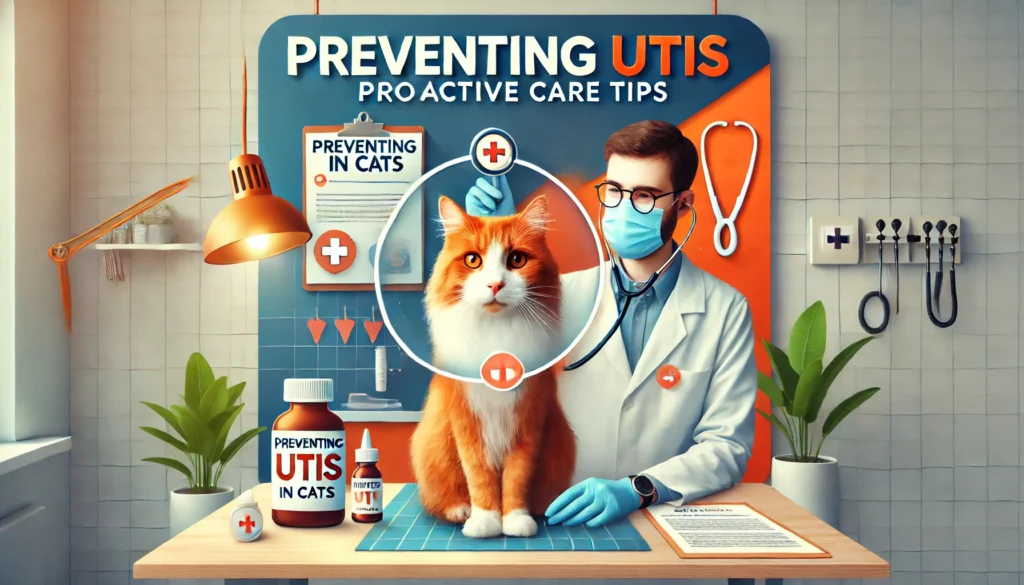UTI in Cats (Urinary Tract Infections in Cats)

Introduction
UTI in Cats (Urinary Tract Infections) can affect their kidneys, bladder, ureters, and urethra. Recognizing the symptoms and understanding treatment options is essential for maintaining your cat’s health. This detailed guide covers everything from symptoms to prevention strategies.
Understanding UTI in Cats
What is a Cat UTI?
A UTI occurs when bacteria enter the urinary tract, leading to an infection, typically of the bladder or urethra. While less common in cats than in dogs, they can be more serious and often signal underlying health issues.
Recognizing the Symptoms of UTI in Cats
UTI in Cats may exhibit signs such as frequent and painful urination, blood in the urine, and urinating in unusual places. Male cats may show symptoms of a UTI through prolonged squatting or distress due to their narrower urethra, which can easily become blocked.
Causes of UTI in Cats
Common Risk Factors
Factors contributing to UTI in Cats include poor hygiene, reduced water intake, obesity, and chronic diseases like diabetes. Male cats, particularly those who are neutered, are at higher risk for urinary blockages that can lead to UTIs.
Diet’s Role in Cat Urinary Health
A cat’s diet significantly impacts urinary health. Foods that help maintain a balanced urinary pH can prevent the formation of crystals or stones, which are common causes of UTIs.

Diagnosing UTI in Cats
How to Tell if Your Cat Has a UTI
Diagnosis begins with recognizing symptoms like difficulty urinating or blood in the urine. A vet can confirm a UTI through tests such as urinalysis and urine culture.
Diagnostic Tests Explained
A urinalysis will check for the presence of red and white blood cells, while a urine culture identifies the specific bacteria causing the infection. Imaging tests like ultrasounds or X-rays might be needed to spot stones or tumors.
Treatment for UTI in Cats
Antibiotics and Other Medications
UTI in Cats are typically treated with antibiotics. It’s crucial for the cat to complete the full course, even if symptoms improve, to avoid recurrence. Pain medications might also be prescribed to manage discomfort.
When Surgery Is Necessary
Cat’s Body Language are often seen as mysterious creatures, their behavior a puzzle to many owners. Understanding cat body language can dramatically improve the relationship between a cat and its owner.
do you know
Cat’s Body Language are often seen as mysterious creatures, their behavior a puzzle to many owners. Understanding cat body language can dramatically improve the relationship between a cat and its owner.
Home Care and Prevention
Managing Your Cat’s Recovery
Ensure your cat has constant access to clean water and monitor its urinary habits closely. A clean litter box also encourages regular urination, helping to flush out bacteria.
Preventing Future UTIs
Preventive measures include maintaining a healthy diet, regular vet check-ups, and ensuring your cat stays hydrated. Specialized urinary health foods may be recommended by your vet.
Conclusion
Understanding UTIs in cats is key to ensuring quick treatment and preventing future issues. Regular veterinary care and attentive home management can help maintain your cat’s urinary health and overall well-being.
How do you know if a cat has a UTI?
Signs of a UTI in a cat include frequent, painful urination, blood in the urine, crying out while urinating, and urinating outside the litter box. A cat may also lick the genital area excessively due to discomfort.
How do I treat a UTI in my cat?
Treatment typically involves antibiotics prescribed by a veterinarian, based on a urine culture to identify the specific bacteria. Increasing water intake and providing a stress-free environment are also important to help recovery.
Can a cat’s UTI heal on its own?
UTIs in cats generally require treatment with antibiotics. Without treatment, the infection can worsen or spread to the kidneys, leading to more serious health issues.
Can cats cause UTI in humans?
No, cats cannot transmit UTIs to humans as the bacteria causing UTIs in cats are different from those that typically cause UTIs in humans.
Can dry food cause UTI in cats?
Dry food, particularly low-quality dry food, can contribute to UTIs and other urinary tract issues in cats because it has low moisture content, which can lead to dehydration and increased concentration of urine.
Can a dirty litter box cause UTI?
While a dirty litter box doesn’t directly cause UTIs, it can lead to urinary tract issues if a cat holds urine for too long due to an aversion to a soiled box, increasing the risk of infection.
Can water cause UTI in cats?
Water itself does not cause UTIs in cats. In fact, increasing water consumption is recommended to help prevent UTIs by diluting the urine and encouraging more frequent urination, which flushes out bacteria.
How can I help my cat pee?
Encourage your cat to drink more water by providing fresh water daily or using water fountains. Wet food can also help increase fluid intake. Make sure the litter box is clean and accessible to encourage regular urination. If your cat is struggling to pee, consult a veterinarian immediately as this can be a sign of a urinary blockage, especially in male cats.
